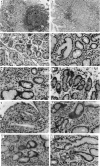Expression of HLA-DR, costimulatory molecules B7-1, B7-2, intercellular adhesion molecule-1 (ICAM-1) and Fas ligand (FasL) on gastric epithelial cells in Helicobacter pylori gastritis; influence of H. pylori eradication
- PMID: 10691918
- PMCID: PMC1905598
- DOI: 10.1046/j.1365-2249.2000.01164.x
Expression of HLA-DR, costimulatory molecules B7-1, B7-2, intercellular adhesion molecule-1 (ICAM-1) and Fas ligand (FasL) on gastric epithelial cells in Helicobacter pylori gastritis; influence of H. pylori eradication
Abstract
There is evidence that Helicobacter pylori infection up-regulates the expression of HLA class II molecules by gastric epithelial cells (GEC). In this study we evaluated whether GEC are capable of expression of costimulatory molecules in H. pylori gastritis. The expression of FasL by GEC, before and after eradication of H. pylori, was also studied. Thirty patients (23 men) aged 27-81 years (53.67 +/- 13.99 years (mean +/- s.d.)) with dyspepsia were studied. Upper gastrointestinal endoscopy was performed and six biopsies were obtained (antrum, n = 3; corpus, n = 3) for Campylobacter-Like Organisms (CLO) test and histology; 23 (16 men) were H. pylori+ and seven (all men) were H. pylori- by both methods and served as controls. Helicobacter pylori eradication therapy was given to H. pylori+ patients and all patients were re-endoscoped after 116 +/- 9 days. Formalin-fixed paraffin-embedded tissue sections were stained by the ABC immunoalkaline phosphatase method. In H. pylori gastritis HLA-DR was expressed and correlated with disease activity (P < 0.01). No HLA-DR was observed in controls. In H. pylori-eradicated patients significant decrease of HLA-DR was found (antrum, P < 0. 001). ICAM-1 was expressed by GEC in 80% of H. pylori+ patients; ICAM-1 expression did not correlate with gastritis parameters and decreased significantly after eradication (antrum, P < 0.01). B7-1 and B7-2 were expressed on H. pylori+ samples and their expression decreased after eradication, albeit not significantly. Weak epithelial expression of both B7 molecules was observed in all the controls. FasL was steadily expressed by GEC in both H. pylori+ and H. pylori- patients and remained almost unchanged after eradication. These findings suggest that GEC may acquire antigen-presenting cell properties in H. pylori infection through de novo expression of HLA-DR and costimulatory molecules. This seems to be attenuated after eradication and resolution of mucosal inflammation. The same cells exhibit the capacity to control the inflammatory process, probably by inducing apoptotic cell death to Fas-bearing infiltrating lymphocytes.
Figures


Similar articles
-
Gastric epithelial cells in Helicobacter pylori-associated gastritis express HLA-DR but not ICAM-1.Scand J Immunol. 1991 Feb;33(2):237-41. doi: 10.1111/j.1365-3083.1991.tb03755.x. Scand J Immunol. 1991. PMID: 2017660
-
Expression of B7-H1 on gastric epithelial cells: its potential role in regulating T cells during Helicobacter pylori infection.J Immunol. 2006 Mar 1;176(5):3000-9. doi: 10.4049/jimmunol.176.5.3000. J Immunol. 2006. PMID: 16493058
-
Local and systemic immune response in Helicobacter pylori-associated chronic gastritis before and after treatment.Scand J Gastroenterol. 1993 Dec;28(12):1105-11. doi: 10.3109/00365529309098317. Scand J Gastroenterol. 1993. PMID: 7905661
-
From the study of tumor cell immunogenicity to the generation of antitumor cytotoxic cells in non-Hodgkin's lymphomas.Leuk Lymphoma. 2000 Jul;38(3-4):247-63. doi: 10.3109/10428190009087016. Leuk Lymphoma. 2000. PMID: 10830732 Review.
-
Muscle-derived positive and negative regulators of the immune response.Curr Opin Rheumatol. 2005 Nov;17(6):714-9. doi: 10.1097/01.bor.0000184164.69181.ca. Curr Opin Rheumatol. 2005. PMID: 16224248 Review.
Cited by
-
Helicobacter pylori persistence: an overview of interactions between H. pylori and host immune defenses.Clin Microbiol Rev. 2006 Oct;19(4):597-613. doi: 10.1128/CMR.00006-06. Clin Microbiol Rev. 2006. PMID: 17041136 Free PMC article. Review.
-
Soluble adhesion molecules ICAM-1, VCAM-1, P-selectin in children with Helicobacter pylori infection.World J Gastroenterol. 2005 Nov 21;11(43):6745-50. doi: 10.3748/wjg.v11.i43.6745. World J Gastroenterol. 2005. PMID: 16425378 Free PMC article.
-
CD54 expression is predictive for lymphatic spread in human gastric carcinoma.Dig Dis Sci. 2005 Dec;50(12):2224-30. doi: 10.1007/s10620-005-3039-1. Dig Dis Sci. 2005. PMID: 16416166
-
Down-regulation of epithelial IL-8 responses in Helicobacter pylori-infected duodenal ulcer patients depends on host factors, rather than bacterial factors.Clin Exp Immunol. 2005 Apr;140(1):117-25. doi: 10.1111/j.1365-2249.2005.02736.x. Clin Exp Immunol. 2005. PMID: 15762883 Free PMC article.
-
Human primary gastric dendritic cells induce a Th1 response to H. pylori.Mucosal Immunol. 2010 May;3(3):260-9. doi: 10.1038/mi.2010.10. Epub 2010 Mar 17. Mucosal Immunol. 2010. PMID: 20237463 Free PMC article.
References
-
- Dooley CP, Cochen H, Fitzgibbons PL, Bauer M, Appleman MD, Perez-Perez GI, Blaser MJ. Prevalence of Helicobacter pylori infection and histologic gastritis in asymptomatic persons. N Engl J Med. 1989;321:1562–6. - PubMed
-
- Kuipers EJ, Thijs JC, Festen HP. The prevalence of Helicobacter pylori in peptic ulcer disease. Aliment Pharmacol Ther. 1995;9(Suppl.):59–69. - PubMed
-
- Parsonnet J, Friedman GD, VanderSteen DP, Chang Y, Vogelman JH, Orentreich N, Sibley RK. Helicobacter pylori infection and the risk of gastric carcinoma. N Engl J Med. 1991;325:1127–31. - PubMed
-
- Eurogast Study Group. An international association between Helicobacter pylori infection and gastric cancer. Lancet. 1993;341:1359–62. - PubMed
-
- Nomura A, Stemmermann GN, Chyou P, Kato I, Perez-Perez GI, Blaser MJ. Helicobacter pylori infection and gastric carcinoma in a population of Japanese Americans in Hawaii. N Engl J Med. 1991;325:1132–6. - PubMed
Publication types
MeSH terms
Substances
LinkOut - more resources
Full Text Sources
Research Materials
Miscellaneous

